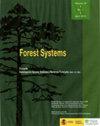Near-infrared spectroscopy for the distinction of wood and charcoal from Fabaceae species: comparison of ANN, KNN AND SVM models
IF 0.7
4区 农林科学
Q3 FORESTRY
引用次数: 4
Abstract
Aim of study: The objective of this work was to evaluate the potential of NIR spectroscopy to differentiate Fabaceae species native to Araucaria forest fragments.Area of study; Trees of the evaluated species were collected from an Araucaria forest stand in the state of Santa Catarina, southern Brazil, in the region to be flooded by the São Roque hydroelectric project.Material and methods: Discs of three species (Inga vera, Machaerium paraguariense and Muellera campestris) were collected at 1.30 meters from the ground. They were sectioned to cover radial variation of the wood (regions near bark, intermediate and near pith). After wood analysis, the same samples were carbonized. Six spectra were obtained from each specimen of wood and charcoal. The original and second derivative spectra, principal component statistics and classification models (Artificial Neural Network: ANN, Support Vector Machines with kernel radial basis function: SVM and k-Nearest Neighbors: k-NN) were investigated.Main results: Visual analysis of spectra was not efficient for species differentiation, so three NIR classification models for species discrimination were tested. The best results were obtained with the use of k-NN for both wood and charcoal and ANN for wood analysis. In all situations, second derivative NIR spectra produced better results.Research highlights: Correct discrimination of wood and charcoal species for control of illegal logging was achieved. Fabaceae species in an Araucaria forest stand were correctly identified.Keywords: Araucaria forest; identification of species; classification models.Abbreviations used: Near infrared: NIR, Lages Herbarium of Santa Catarina State University: LUSC, Principal component analysis: PCA, artificial neural network: ANN, support vector machines with kernel radial basis function: SVM, k-nearest neighbors: k-NN.豆科树种木材和木炭的近红外光谱区分:ANN、KNN和SVM模型的比较
研究目的:探讨近红外光谱技术在豆科植物鉴别中的应用价值。研究领域;被评估物种的树木是从巴西南部圣卡塔琳娜州的一个Araucaria森林中收集的,该地区将被奥罗克水电项目淹没。材料与方法:在距地面1.30 m处采集Inga、Machaerium paraguariense和Muellera campestris 3种植物的叶片。它们被切片以覆盖木材的径向变化(树皮附近、中间和髓附近的区域)。木材分析后,同样的样品被碳化。从每个木材和木炭样品中获得6个光谱。研究了原始和二阶导数谱、主成分统计和分类模型(人工神经网络:ANN、核径向基支持向量机:SVM和k近邻:k-NN)。主要结果:光谱的目视分析对物种区分效率不高,因此对三种近红外物种分类模型进行了测试。用k-神经网络分析木材和木炭,用神经网络分析木材,结果最好。在所有情况下,二阶导数近红外光谱产生更好的结果。研究重点:实现了正确区分木材和木炭种类,控制非法采伐。正确鉴定了南芥林分区内的豆科植物。关键词:刺槐林;物种鉴定;分类模型。使用的缩写:近红外:NIR,圣卡塔琳娜州立大学Lages标本馆:LUSC,主成分分析:PCA,人工神经网络:ANN,核径向基支持向量机:SVM, k近邻:k-NN。
本文章由计算机程序翻译,如有差异,请以英文原文为准。
求助全文
约1分钟内获得全文
求助全文
来源期刊

Forest Systems
FORESTRY-
CiteScore
1.40
自引率
14.30%
发文量
30
审稿时长
6-12 weeks
期刊介绍:
Forest Systems is an international peer-reviewed journal. The main aim of Forest Systems is to integrate multidisciplinary research with forest management in complex systems with different social and ecological background
 求助内容:
求助内容: 应助结果提醒方式:
应助结果提醒方式:


